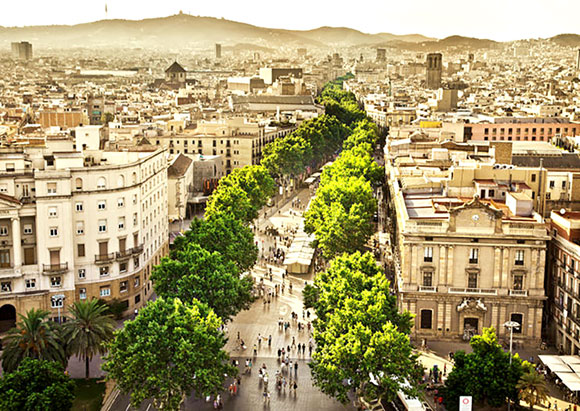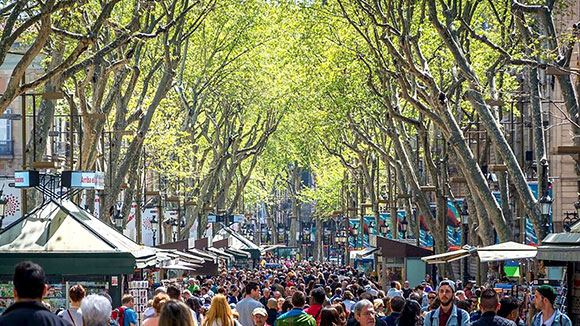(The opinions and views expressed in the commentaries and letters to the Editor of The Somerville Times belong solely to the authors and do not reflect the views or opinions of The Somerville Times, its staff or publishers)

By William C. Shelton
The poet Federico Garcia Lorca wrote that La Rambla was the only street in the world that he wished would never end. It is a linear plaza running three-quarters of a mile, from Barcelona’s center to the Mediterranean.
Overarching deciduous trees provide summer shade and conduct winter sunshine while buffering the plaza from what we in Somerville now call “calmed” auto traffic on either side.
Visual artists sell their work in the plaza. Street-food stalls feed passersby. Musicians and dancers perform. Lovers promenade together, while geezers like me take the air, encountering old friends and making new acquaintances.

Viewed from the Mediterranean’s edge, La Rambla continues out of sight to the city’s center.
What resurrects my memories of La Rambla – and its twin, Havana’s Paseo del Prado – is the city planning staff’s effort to update the Assembly Square Neighborhood Plan. Although live public participation is scheduled throughout this week, you can continue to submit your ideas in writing and online, as well as in the “charrette” sessions.
My fondest wish for Assembly Square is for La Rambla to run its north-south length. More on that later.
It’s difficult to overstate the importance of getting Assembly Square right. Not doing so would squander the $10-billion road, rail, highway, bike trail and water transport nexus that surrounds it like no other critical mass of developable land remaining in Greater Boston.
Such squandering almost happened twenty years ago. But an eight-year conflict prevented development of a collection of suburban-style big-box stores and eventually yielded peace, and development of Assembly Row as we now enjoy it.
The fact is that Somerville cannot achieve live-work balance and meet its goals for jobs, fiscal health, open space, affordable housing, and sustainability without developing the right mix of uses in Assembly Square. And those uses won’t attract and retain users without effective and appealing design of their built environment. In hopes of contributing to that effort, I offer the following wish list.

Perspective foreshortens the view and compresses the crowd under spring leaves.
Plan for a use mix that can pay for what Somerville needs and moderate residential taxes. The Plan must serve the whole city since we have no other asset like Assembly Square. A mix of commercial and great open-space uses should dominate all future development in Assembly Square, with supporting hotels, services, entertainment, and retail.
Build just enough residential uses to ensure the eighteen-hour street activity that increases security. Commercial uses can generate tax revenues that support affordable housing elsewhere in the city. But few other Somerville locations can host similar commercial uses that generate equivalent tax revenue.
Ensure that a substantial portion of residential units can accommodate families, particularly in meeting the 20% affordability requirement. If we want a real neighborhood, we need kids and the relationships that adults form around them. Explore the feasibility of market-rate workforce housing, i.e., housing affordable to households earning 80-to-120% of Area Median Income.
Build high to maximize (and pay for) green space. Moderately tall commercial buildings along I-93 can also help reduce deadly ultrafine particle pollution for the rest of the Square.
Maintain continuous street walls with lots of windows and doors. Humans feel more secure when buildings come up to the sidewalk and do not have blank walls. They are more engaged and linger when building surfaces are interesting. Good design can make small pocket parks part of the street wall and a much-appreciated amenity. But…
Concentrate usable green space to achieve scale.
Require underground parking and, wherever possible, activated and/or green roofs. This adds to development costs, but tall buildings can amortize those costs over more leasable square feet.
Strengthen pedestrian, auto, transit and bicycle connections with the rest of Somerville and the region. Do not allow construction that would preclude the eventual possibility of a McGrath Highway extension under I-93, connecting to Foley Street.
Don’t be concerned about keeping the courthouse as it is if its demolition and its replacement – there or elsewhere – can produce a better plan. It is not an historical or noteworthy building. Its green space is now not usable while it could host something that buffers Assembly Square from McGrath traffic. And finally,
Build a paseo like La Rambla running the north-south length of Assembly Square. Site it along Grand Union Boulevard’s present location or (less desirably) along the driveway that now fronts the Assembly Marketplace and Home Depot buildings and bisects the Xmbly site.
I challenge anyone to show me how this is frivolous or unfeasible. It would serve as a community center and gathering place for the neighborhood. It would be an enormous draw of customers for the Square’s retail vendors and service providers. It would be a compelling amenity for office workers and hotel guests. It would attract visitors from across the region.
And it would leverage the social capital represented by Somerville’s highest-in-New-England proportion of visual and performing artists. It would create a marketplace for them, with minimal costs to them.
Think about it. Meanwhile, I hope that my wish list has stimulated your own wishful thinking. Please share your thoughts as part of the planning process. It takes a village of diverse citizens to evolve great places.















all good ideas. I would also like to think about how we can better connect assembly to the rest of Somerville.. also what are some of the lessons learned that can be applied to a redevelopment of innerbelt and union sq.
Great idea. Such a shame Assembly Row itself was not fully pedestrianized, when the initial renderings suggested it would be.